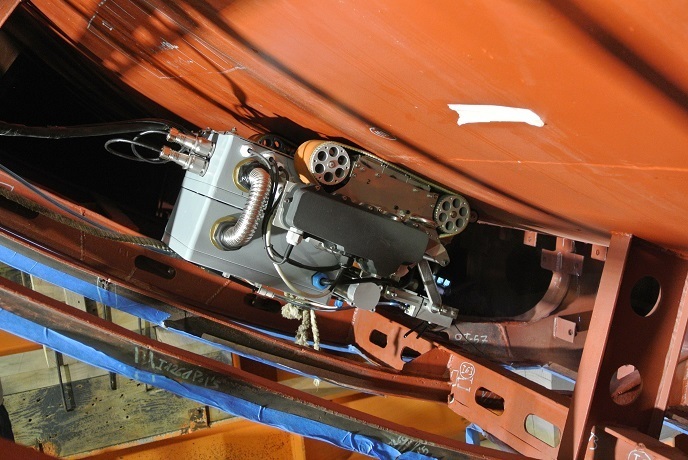Robots take over hull inspection on ships
The EU is home to the world’s largest shipping fleet. At the start of 2014, the EU-controlled fleet included 450 million gross tonnes and 23 000 vessels. Simply put, the EU controls around 40 % of the world’s tonnage(opens in new window) and can boast of having the world’s youngest and most innovative fleet. Non-destructive testing (NDT) methods are powerful, non-invasive techniques used to determine the integrity of a component or structure. Safety-critical weld length exceeds 120 km in large vessels. Inspections are usually carried out in dry docks twice during the first decade of a vessel’s lifetime. Dry-dock inspections are a major concern for ship owners: the costs can be as high as EUR 150 000 per inspection.
Inspecting welds in a single pass
At the moment, inspection of welded joints is typically carried out by radiography, ultrasonics, magnetic particle testing or liquid penetrant testing. Each method requires a person on-site for carrying out weld inspections. The EU-funded ShipTest(opens in new window) project sought to redefine NDT inspection by commercialising Spectre-X, a robotic inspection platform for detecting welding defects and mapping corrosion in ships from cradle to grave. “Building on the developments of the FP7 project X-Scan(opens in new window), Spectre-X uses a combination of phased array ultrasonic testing (PAUT) and alternating current field measurement (ACFM) technologies to make inspections more efficient and cost effective. The system can inspect welding defects on thin metal plates without the need to remove coating,” notes Dr Kyriakos Berketis, ShipTest coordinator. Spectre-X increases efficiency by combining multiple methods for volumetric and surface weld inspection in a single pass. It is therefore labour saving, increasing the overall inspection safety while decreasing expenses and lowering the requirement for specialised operators’ knowledge. The data produced is uploaded on a secure private cloud platform for remote analysis. “This platform could act as a base where all type of inspection information can be uploaded – it is like keeping a medical record for a ship,” adds Berketis.
Spectre-X competitive edge
“Combining three NDT techniques – rather than using one – in a single box that weights around 25 kg was a feat,” reports Berketis. Importantly, this box combines certain NDT technologies that allow easier and more accurate inspections. For example, the ACFM probe introduces an electric current locally into the metal surface and measures the associated electromagnetic fields close to the weld. The presence of an exposed crack disturbs the associated fields and the information is graphically presented to the operator. “ACFM is a better alternative to manual techniques that involve the use of magnets. Although the latter can also detect the perturbed magnetic field spreading out from the surface defect, they do not provide information about how deep the defect is,” explains Berketis. Another advantage Spectre-X boasts is that it uses techniques that allow PAUT to inspect defects in metal plates of less than 10 mm. Although PAUT techniques can inherently ‘see’ within lesser thicknesses, this is not the case with most commercial systems. Therefore, operators have been using radiography, which, despite its benefits, raises health and safety concerns. Ultimately, what is unique about Spectre-X is that it can also be used in a marine environment to perform corrosion mapping while the ship is afloat. Unless there has been some significant change in the shape or size of the ship throughout its lifetime, inspection of welding defects usually takes place in newly built ships. “Extensive communication with marine professionals, ship owners and system operators made us consider expanding the envelope of services Spectre-X offers,” concludes Berketis.







